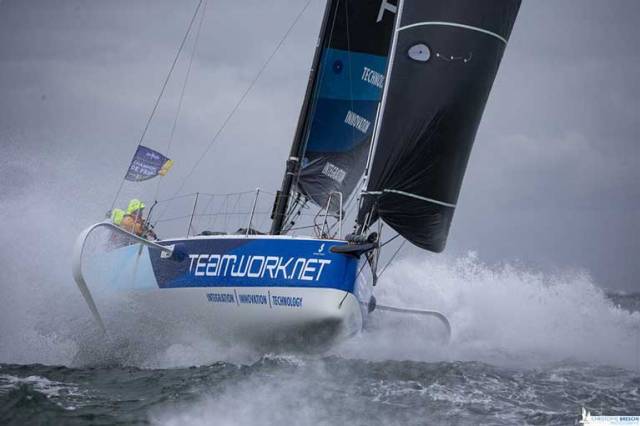The miraculous years of 2016 and 2017 provided a magic time in Irish sailing writes W M Nixon. Annalise won her Olympic Silver Medal. Shane McCarthy won the GP14 Worlds. And the most glamorous Round Ireland Race ever staged saw George David’s Rambler 88 and the three MOD 70 trimarans set course records every which way.
Then in the Autumn Enda O’Coineen went off in the Vendee Globe. And our interest in the big race didn’t stop there, as Stewart Hosford through Alex Thomson, and Marcus Hutchinson with his involvement in several boats, gave us an interest in campaigns at every level in this stratospheric peak of sailing ambition.
Came 2017, and Conor Fogerty won his class in the OSTAR, while Tom Dolan continued to make a more significant impact in France with the Mini Transat. Michael Boyd won the RORC Championship overall with the First 44.7 Lisa. And at junior level, there were new stars emerging with reassuring regularity and frequency in several classes at home and internationally.
It was good. In fact, it felt too good to be true. People were dreaming dreams. Even the most grounded people started to dream dreams. And the dream, in this case, was the Vendee Globe 2020. Tens of thousands of miles of everything our planet’s oceans can throw at extreme IMOCA 60s requiring superhuman feats of endurance.
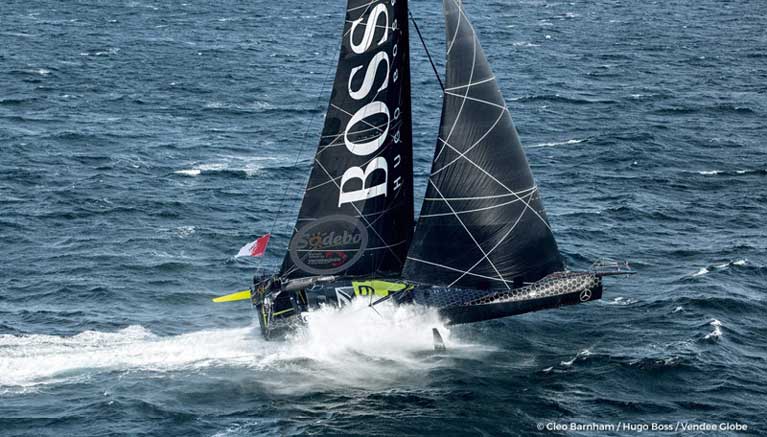 Alex Thomson’s IMOCA 60 Hugo Boss. The skipper is very British, and the sponsors are undoubtedly German, but they need a major French event to show what they can do.
Alex Thomson’s IMOCA 60 Hugo Boss. The skipper is very British, and the sponsors are undoubtedly German, but they need a major French event to show what they can do.
The more demanding the Vendee Globe challenge, the greater the number of Irish sailors who spoke of their interest in being there on the starting line next time round, on 8th November 2020. At various stages proven sailors as diverse as Conor Fogerty, Sean McCarter, Nin O’Leary, Joan Mulloy and Tom Dolan have been testing the sometimes distinctly tepid waters of potential Irish and international sponsorship support for the 2020 race.
Of course, we have to recognise that the difference between an expression of interest and the announcement of a full-blown campaign is a very wide gulf, and if everything is going the right way, there is much that can happen in the year or so that is arguably still available.
Yet here we are now, with eight and perhaps even nine totally new IMOCA 60 boats well under construction in Europe with the 2020 race less than 19 months away, and not one of any of the entries - new or second-hand - seems to be Irish. This despite the fact that there are now so many IMOCA 60s of varying vintages around that the Rolex Fastnet Race of 3rd August 2019 has an entry of 29 of these remarkable machines. And the fact that one of them, Mike Golding’s boat the former Gamesa, has Joan Mulloy in the personnel lineup certainly provides a line of possibility.
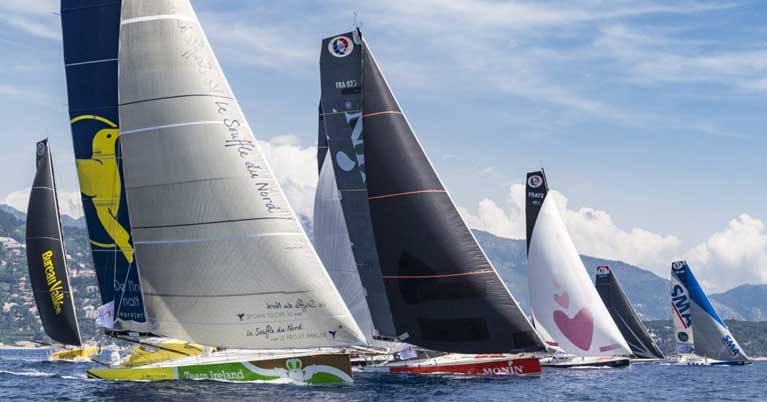 There’s a lot of them about……Imoca 60s at Monaco in June 2018, with Souffle du Nord/Team Ireland in foreground racing to success for Thomas Ruyant and Joan Mulloy. In the 2016 Vendee Globe, Ruyant’s Souffle was forced into port in New Zealand following hull damage from a submerged object, and after repairs was sailed back to France by Enda O Coineen
There’s a lot of them about……Imoca 60s at Monaco in June 2018, with Souffle du Nord/Team Ireland in foreground racing to success for Thomas Ruyant and Joan Mulloy. In the 2016 Vendee Globe, Ruyant’s Souffle was forced into port in New Zealand following hull damage from a submerged object, and after repairs was sailed back to France by Enda O Coineen
But the Fastnet Race, while challenging, is more of a display case for the highly-specialised offwind-oriented IMOCA 60s than a proper contest. For the Fastnet has a very manageable timespan as opposed to the resources-devouring full-on Vendee Globe campaign, which requires major expenditure decisions from sponsors. And in today’s uncertain economic and political times, many big business decisions are being put on hold.
However, part of the big-time sponsorship process involves long hours of detailed presentations in powerful board-rooms, in an atmosphere about as remote as possible from the realities of racing the Great Southern Ocean. Such serious negotiations could be going on in total privacy even as we speak. In fact, as recent Irish experience has shown, premature announcements of quests for sponsorship can be seriously counter-productive. And “serious” is scarcely the word for it – after all, for a top end new boat, we’re talking of a basic budget of €2.5 to €3 million, effectively for three years although there’s value added in that, post race, the boats are now eligible to be modified for participation in 2021’s Ocean Race.
So speculation on permutations of fate continues to be rife. But for now, we’ll stick to the known knowns. For we do of course have Stewart Hosford of Cork and his team beavering away in a building unit near Southampton on the new Hugo Boss for Alex Thomson. And in Lorient in Brittany, the many talents of Marcus Hutchinson of Kinsale and formerly Howth are being deployed on another IMOCA 60, this time for the formidably-focused and proven talent of Thomas Ruyant of Dunkerque.
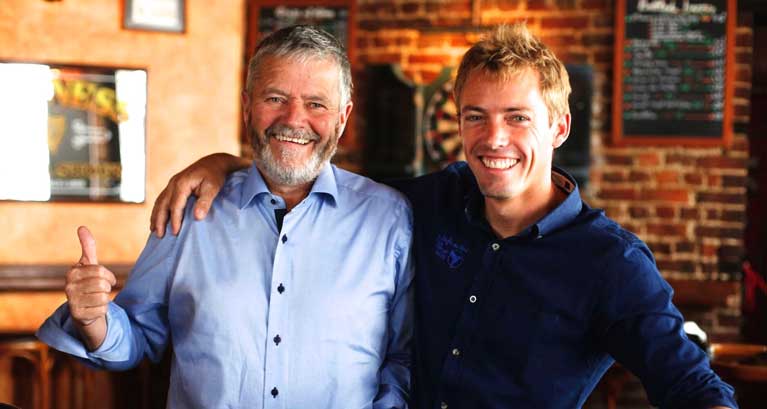 Enda O’Coineen and Thomas Ruyant
Enda O’Coineen and Thomas Ruyant
But Hosford and Hutchinson have been in the inside track for quite a while. As for other names, Joan Mulloy and Tom Dolan are having mixed fortunes in the Sardinha Cup, the opening salvo of the Figaro Solo season, which will bring the fleet to Kinsale in early June as a stopover in La Solitaire URGO Figaro 2019 itself, the Golden Jubilee.
Aboard with Dolan for the Sardinha is Damian Foxall, who is head and shoulders above all other Irish sailors in the success of his career which emerged from the French professional sailing structure. Yet Foxall turns 50 next year, and while the 73-year-old Jean-Luc van den Heede proved with his victory in the Golden Globe Golden Jubilee in January that age is not necessarily a matter of chronology, Foxall is showing involvement in other areas such as the environment which may become his dominant interest.
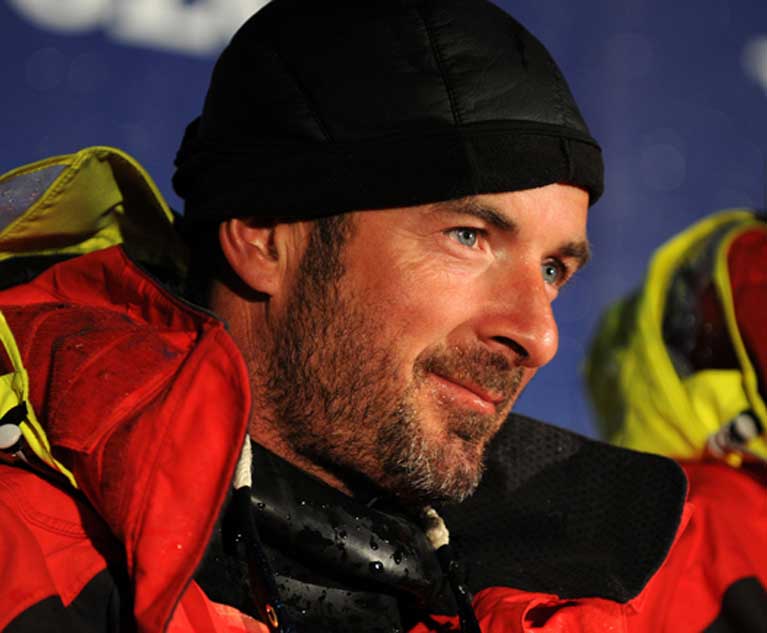 Damian Foxall, Ireland’s mega-race superstar
Damian Foxall, Ireland’s mega-race superstar
But for now, with the clock ticking remorselessly towards 8th November 2020, the likelihood of an Irish skipper in charge of a truly competitive IMOCA 60 seems increasingly remote. Yet as the underlying sense of excitement builds up, there are always new talents emerging over the horizon to whom the Vendee Globe and other major events call. So what would we say to some young, ambitious and talented Irish sailor who is thinking of moving into this unforgiving yet sometimes highly rewarding big-time offshore scene?
Basically, you’ve to face up to the French reality. France holds a unique position in world sailing, with a distinctive strength and status in the sport which often enables it to dictate the international agenda. And when world maritime attention focuses – as it does with increasing frequency – on a selection of major French events, they somehow manage to seem accessible, yet in their ultimate manifestations are clearly the sailing of superstars.
For the most ambitious young Irish sailors, this French hegemony presents a dilemma, and it’s not for everyone. Rather than being sucked into it, you can, of course, avoid the French power-pull, and instead take the standard Irish international performance sailing route, which is based around World Sailing’s global programme, with the glitter of the Olympics inevitably at its core. Theoretically, you are supported along the way, but resources often seem scarce, and the close public attention can be stressful in itself
On the other hand, you can strike out with any outstanding ability in the less structured Anglo-Saxon word of major events, in which wealthy individual owners are always on the lookout for special talent – three notable successes in this category are skipper/helmsmen Harold Cudmore and Gordon Maguire, and navigator Ian Moore, of whom it has been said that having him on a Transatlantic race is as good as narrowing the ocean by at least 150 miles.
 The 212ft Ron Holland-designed superyacht Perseus, skippered to success by Nin O’Leary
The 212ft Ron Holland-designed superyacht Perseus, skippered to success by Nin O’Leary
This line of approach may then overlap into high profile happenings like The Ocean Race - formerly the Volvo – while in a different direction, the growth of very private superyacht regattas means that an Irish sailing star who has shown he or she can make the glossy giants sail well is going to be very much in demand, but discretion is expected. Nevertheless, we did manage to find out that in one example, Nin O’Leary was called in to get the best performance out of the 212ft Ron Holland-designed sloop Perseus (that really is 212 feet, and she really does have only one mast), and he did the business to leave an owner very happy indeed.
Equally complex in its way is the America’s Cup where – despite continuous reassurances of its relevance to everyday sailing and the benefits of the trickle-down effect of the technology it develops – the feeling is inescapable that you’re in a parallel universe rather than an integral part of the world sailing scene.
But in France, because of the corporate nature of the social structures, and the way that harbour towns, regions and national utilities are expected to promote themselves with commercial vigour, there’s a unique maritime setup in which top-end sailing is very much part of national life.
2024 Sailing Olympics
For those who would wish to make their way in it as a career, it is by no means a bed of roses. It is tough – very tough. But nevertheless it most definitely is there, it provides a recognizable path of progress, and a few Irish sailors – a very few, admittedly – have found fulfilment through the French system.
 Focal point of world sailing. The Paris Boat Show, December 2018, and Joan Mulloy, Irish Sailing President Jack Roy, and Tom Dolan are in town for the draw for the new Figaro 3s for the 2019 season. Photo: Rosemary Roy
Focal point of world sailing. The Paris Boat Show, December 2018, and Joan Mulloy, Irish Sailing President Jack Roy, and Tom Dolan are in town for the draw for the new Figaro 3s for the 2019 season. Photo: Rosemary Roy
It’s not a potential career path which will lessen any time soon, for France is going to host the 2024 Olympics. And as it was a Frenchman, Baron Pierre de Coubertin, who is generally credited with re-inventing the ancient Greek games in the beginnings of their modern form in 1896, the French can have a somewhat proprietorial attitude towards the Olympics. This will particularly manifest itself in the sailing, for boat change is always in the air with the long four-year Olympic cycle, and when possible, hosting nations do everything to promote boats from their own designers and builders for the accolade of Olympic selection.
It’s a mixed blessing, for at the moment only the venerable Laser manages to be both an Olympic class and a popular boat at grass roots level. But nevertheless we’ve already had the report in Afloat on testing for a new women’s single-hander, and while the tests may have taken place in Valencia in Spain, you couldn’t help but notice that a French boat was very much in evidence.
This approach is much more apparent in the intriguing new development with introducing offshore racing as an Olympic discipline, the proposal from the World Sailing Equipment Committee being that the new boat - which is not to be a foiler – is to be sailed by a woman and a man.
Currently, the new boat which has been grabbing the headlines is the foiling Figaro 3, whose current debut with the Sardinha Cup has been sending out very mixed messages. The boat has tremendous potential, but the excessive occurrence of rig failures this past week shows there is much work to be done before the fleet launches into the Golden Jubilee Figaro itself in just six weeks time.
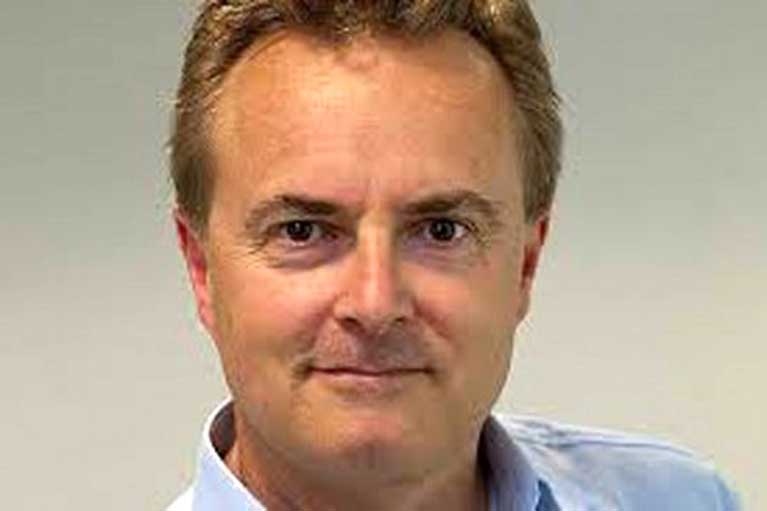 Marcus Hutchinson recently presented proposals for an adapted version of the Figaro 3 as an Olympic offshore training boat
Marcus Hutchinson recently presented proposals for an adapted version of the Figaro 3 as an Olympic offshore training boat
Meanwhile, others have been thinking beyond this current Figaro, beyond the Fastnet, beyond the Vendee Globe, and on to the possibilities which the introduction of an offshore racing class in the Sailing Olympics at Marseille in 2024 will offer, and this month in France, Marcus Hutchinson presented a discussion document on realities and possibilities for developing Olympic two-handed mixed gender offshore teams to the Figaro Beneteau 3 Academy.
It’s high-powered stuff, and you can reach your own conclusions and queries from studying it in its raw form. But for the inevitable and instant “How much?” query, the answer is that bringing a qualified crew to the required offshore racing level for realistic participation in the 2024 Olympics, you’ll be looking at a basic budget of €800,000 a year.
And as for the suggestion that there might usefully be a de-foiled version of the Figaro 3, may that’s not such a bad idea. In its current form, the FB3 has no less than five appendages sticking out under the bull. Just ask Tom Dolan and Damian Foxall what happens when you get that particular bag of tricks in among some abandoned fishing gear…….
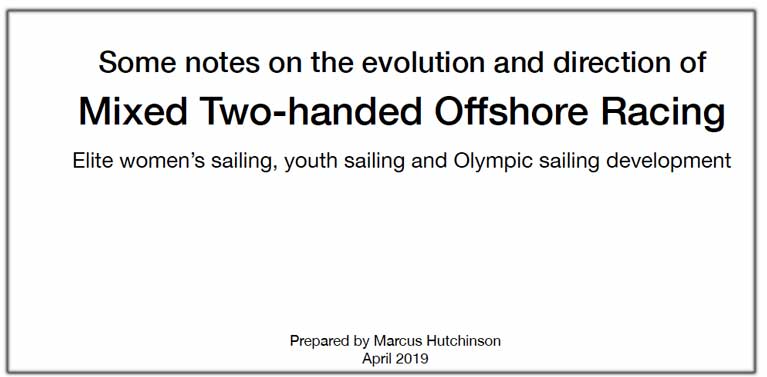 Marcus Hutchinson's presentation is available to download below in PDF format
Marcus Hutchinson's presentation is available to download below in PDF format




























